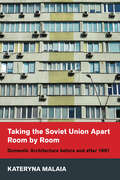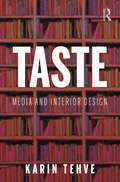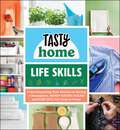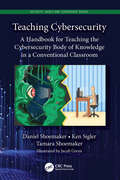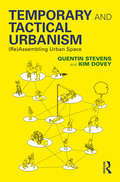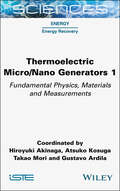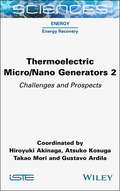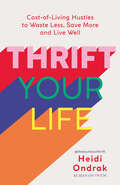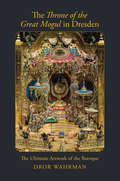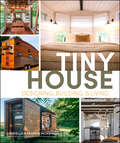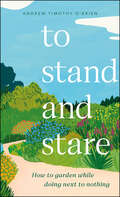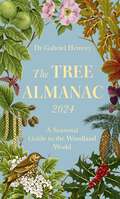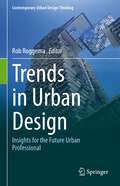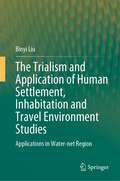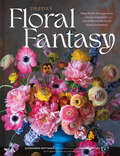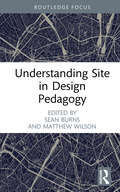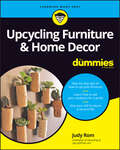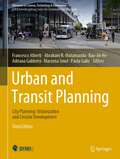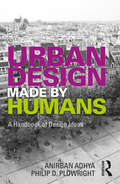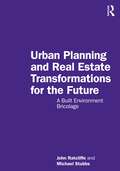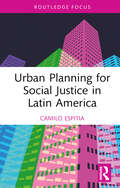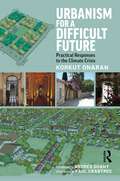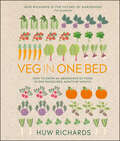- Table View
- List View
Taking the Soviet Union Apart Room by Room: Domestic Architecture before and after 1991 (NIU Series in Slavic, East European, and Eurasian Studies)
by Kateryna MalaiaTaking the Soviet Union Apart Room by Room investigates what happens to domestic spaces, architecture, and the lives of urbanites during a socioeconomic upheaval. Kateryna Malaia analyzes how Soviet and post-Soviet city dwellers, navigating a crisis of inadequate housing and extreme social disruption between the late 1980s and 2000s, transformed their dwellings as their countries transformed around them. Soviet infrastructure remained but, in their domestic spaces, urbanites transitioned to post-Soviet citizens. The two decades after the collapse of the USSR witnessed a major urban apartment remodeling boom. Malaia shows how, in the context of limited residential mobility, those remodeling and modifying their homes formed new lifestyles defined by increased spatial privacy. Remodeled interiors served as a material expression of a social identity above the poverty line, in place of the outdated Soviet signifiers of well-being. Connecting home improvement, self-reinvention, the end of state socialism, and the lived experience of change, Malaia puts together a comprehensive portrait of the era. Malaia shows both the stubborn continuities and the dramatic changes that accompanied the collapse of the USSR. Making the case for similarities throughout the former Soviet empire, this study is based on interviews and fieldwork done primarily in Kyiv and Lviv, Ukraine. Many of the buildings described are similar to those damaged or destroyed by Russian bombings or artillery fire following the invasion of Ukraine on February 24, 2022. A book about major historic events written through the lens of everyday life, Taking Soviet Union Apart is also about the meaning of home in a dramatically changing world.
Taking the Soviet Union Apart Room by Room: Domestic Architecture before and after 1991 (NIU Series in Slavic, East European, and Eurasian Studies)
by Kateryna MalaiaTaking the Soviet Union Apart Room by Room investigates what happens to domestic spaces, architecture, and the lives of urbanites during a socioeconomic upheaval. Kateryna Malaia analyzes how Soviet and post-Soviet city dwellers, navigating a crisis of inadequate housing and extreme social disruption between the late 1980s and 2000s, transformed their dwellings as their countries transformed around them. Soviet infrastructure remained but, in their domestic spaces, urbanites transitioned to post-Soviet citizens. The two decades after the collapse of the USSR witnessed a major urban apartment remodeling boom. Malaia shows how, in the context of limited residential mobility, those remodeling and modifying their homes formed new lifestyles defined by increased spatial privacy. Remodeled interiors served as a material expression of a social identity above the poverty line, in place of the outdated Soviet signifiers of well-being. Connecting home improvement, self-reinvention, the end of state socialism, and the lived experience of change, Malaia puts together a comprehensive portrait of the era. Malaia shows both the stubborn continuities and the dramatic changes that accompanied the collapse of the USSR. Making the case for similarities throughout the former Soviet empire, this study is based on interviews and fieldwork done primarily in Kyiv and Lviv, Ukraine. Many of the buildings described are similar to those damaged or destroyed by Russian bombings or artillery fire following the invasion of Ukraine on February 24, 2022. A book about major historic events written through the lens of everyday life, Taking Soviet Union Apart is also about the meaning of home in a dramatically changing world.
Taste: Media and Interior Design
by Karin TehveThis book traces and explores the evolution of taste from a design perspective: what it is, how it works, and what it does. Karin Tehve examines taste primarily through its recursive relationship to media. This ongoing process changes the relationship between designers and the public, and our understanding of the relationship of individuals to their social contexts. Through an analysis of taste, design is understood to be an active constituent of social life, not as autonomous from it. This book reclaims a term long dismissed from interior design and unveils taste’s role as a powerful social and political agent within systems of aesthetics, affecting both its producers and consumers. Each chapter discusses a taste concept or definition, analyzes its reciprocal relationship with media, and explores its implications for interior design. Illustrated with 70 images, taste’s relationship to media is viewed through a variety of different lenses, including books, photography, magazines, internet, social media and algorithms. Written primarily for students and scholars of interior design and related design fields, this book will be a helpful resource for all those interested in the question of taste, and is an invitation to produce and consume all media critically.
Tasty Home: From Organizing Your Kitchen to Saving a Houseplant, Money-Saving Hacks and Easy DIYs You Need to Know (Tasty Home Series)
by Tasty HomeDiscover all the life hacks you&’ve been missing with this perfect compendium of skills to answer all of life&’s most asked questions from BuzzFeed&’s popular lifestyle destination Tasty Home. Need help unclogging a drain? Can&’t seem to keep a plant alive? Just want to finally know how to fold a fitted sheet? Let BuzzFeed&’s Tasty Home make your life a whole lot easier. With Tasty Home: Life Skills, you&’ll learn simple tricks, helpful hacks, and super easy DIYs to increase your how-to knowledge. This book teaches you everything you need to know—even things you didn&’t know you needed to know! Based on the most searched topics on Tasty Home&’s site and social channels, this go-to guide covers the kind of questions that would have you calling mom. Now, you can secure your spot as a real-life adult whether you need to fix a kitchen fail or quickly sew on a button, this book has your back. Tasty Home: Life Skills packs all the fun and helpful info of BuzzFeed&’s how-to site into the perfect guide you&’ll find yourself going back to again and again.
Teaching Cybersecurity: A Handbook for Teaching the Cybersecurity Body of Knowledge in a Conventional Classroom (Security, Audit and Leadership Series)
by Daniel Shoemaker Ken Sigler Tamara ShoemakerLet’s be realistic here. Ordinary K-12 educators don’t know what "cybersecurity" is and could probably care less about incorporating it into their lesson plans. Yet, teaching cybersecurity is a critical national priority. So, this book aims to cut through the usual roadblocks of confusing technical jargon and industry stovepipes and give you, the classroom teacher, a unified understanding of what must be taught. That advice is based on a single authoritative definition of the field. In 2017, the three societies that write the standards for computing, software engineering, and information systems came together to define a single model of the field of cybersecurity. It is based on eight building blocks. That definition is presented here. However, we also understand that secondary school teachers are not experts in arcane subjects like software, component, human, or societal security. Therefore, this book explains cybersecurity through a simple story rather than diving into execution details. Tom, a high school teacher, and Lucy, a middle school teacher, are tasked by their district to develop a cybersecurity course for students in their respective schools. They are aided in this by "the Doc," an odd fellow but an expert in the field. Together they work their way through the content of each topic area, helping each other to understand what the student at each level in the educational process has to learn. The explanations are simple, easy to understand, and geared toward the teaching aspect rather than the actual performance of cybersecurity work. Each chapter is a self-contained explanation of the cybersecurity content in that area geared to teaching both middle and high school audiences. The eight component areas are standalone in that they can be taught separately. But the real value lies in the comprehensive but easy-to-understand picture that the reader will get of a complicated field.
Temporary and Tactical Urbanism: (Re)Assembling Urban Space
by Quentin Stevens Kim DoveyTemporary and Tactical Urbanism examines a key set of urban design strategies that have emerged in the twenty-first century. Such projects range from guerrilla gardens and bike lanes to more formalised temporary beaches and swimming pools, parklets, pop-up plazas and buildings and container towns. These practices enable diverse forms of economic, social and artistic life that are usually repressed by the fixities of urban form and its management. This book takes a thematic approach to explore what the scope of this practice is, and understand why it has risen to prominence, how it works, who is involved, and what its implications are for the future of city design and planning. It critically examines the material, social, economic and political complexities that surround and enable these small, ephemeral urban interventions. It identifies their short-term and long-term implications for urban intensity, diversity, creativity and adaptability. The book's insights into temporary and tactical urbanism have particular relevance in the context of the COVID-19 pandemic, which has highlighted both the need and the possibility of quickly transforming urban spaces worldwide. They also reveal significant lessons for the long-term planning and design of buildings, landscapes and cities.
Thermoelectric Micro / Nano Generators, Volume 1: Fundamental Physics, Materials and Measurements
by Hiroyuki Akinaga Atsuko Kosuga Takao Mori Gustavo ArdilaThis book explores a key technology regarding the importance of connections via an Internet of Things network and how this helps us to easily communicate with others and gather information. Namely, what would happen if this suddenly became unavailable due to a shortage of power or electricity? Using thermoelectric generators is a viable solution as they use the heat around us to generate the much-needed electricity for our technological needs. This first volume explores the computational and data-driven development of these thermoelectric generators, as well as the use of various abundant materials such as copper and silver chalcogenides and nanocarbons. It also offers reviews on universal property enhancement principles and the case of strongly correlated oxides, and goes on to explore the metrology of the thermal properties of thermoelectric generators, detailing methods of how to measure the absolute Seebeck coefficient using the Thomson effect and the thermal diffusivity of thin films using the ultrafast laser flash method.
Thermoelectric Micro / Nano Generators, Volume 2: Challenges and Prospects
by Hiroyuki Akinaga Atsuko Kosuga Takao Mori Gustavo ArdilaThis book explores a key technology regarding the importance of connections via an Internet of Things network and how this helps us to easily communicate with others and gather information. Namely, what would happen if this suddenly became unavailable due to a shortage of power or electricity? Using thermoelectric generators is a viable solution as they use the heat around us to generate the much-needed electricity for our technological needs. This second volume on the challenges and prospects of thermoelectric generators covers the reliability and durability of thermoelectric materials and devices, the effect of microstructures on the understanding of electronic properties of complex materials, thermoelectric nanowires, the impact of chemical doping or magnetism, thermoelectric generation using the anomalous Nernst effect, phonon engineering, the current state and future prospects of thermoelectric technologies, transition metal silicides, and past, present and future applications of thermoelectrics.
Thrift Your Life: Cost-of-Living Hustles to Waste Less, Save More and Live Well
by Heidi OndrakThe Queen of Thrift.' The Sun 'Super Saver Mum shares simple tips.' Daily MailFull of hacks and hustles to navigate those sudden changes in fortune that none of us could have predicted. This is a no-nonsense guide on how to change your habits to weather the storm, written by TikTok's queen of budgeting, Heidi Ondrak, aka The Duchess of Thrift.Life rarely follows a linear path, sh*t happens that you could have controlled better, and then stuff happens that you have absolutely no control over whatsoever, like the current cost-of-living crisis. Full of practical hacks to adapt to life's financial ups and downs and guaranteed to help you save every month, Heidi will show you how to nurture resilience alongside some of those cheeky life hacks that no one teaches in schools. Think of it as a modern-day take on Mrs Beeton's Book of Household Management, with extra sass.Hacks range from the well-versed and practical to the downright outrageous – pick and choose, do what suits you. Heidi will help you build a toolkit to get you through the crisis and feel prepared and in control for more energy increases, interest rate rises and eye-watering inflation, while doing it with a fighting spirit and sunny demeanor. You'll learn how to change your mindset, get the family on board, carry out budget health checks, shop smarter, look a million dollars for pennies, have great days out, enjoy Xmas and be able to get around... All on a shoestring!
The Throne of the Great Mogul in Dresden: The Ultimate Artwork of the Baroque
by Dror WahrmanA masterful deciphering of an extraordinary art object, illuminating some of the biggest questions of the eighteenth century The Throne of the Great Mogul (1701–8) is a unique work of European decorative art: an intricate miniature of the court of the Mughal emperor Aurangzeb depicted during the emperor&’s birthday celebrations. It was created by the jeweler Johann Melchior Dinglinger in Dresden and purchased by the Saxon prince Augustus the Strong for an enormous sum. Constructed like a theatrical set made of gold, silver, thousands of gemstones, and amazing enamel work, it consists of 164 pieces that together tell a detailed story. Why did Dinglinger invest so much time and effort in making this piece? Why did Augustus, in the midst of a political and financial crisis, purchase it? And why did the jeweler secrete in it messages wholly unrelated to the prince or to the Great Mogul? In answering these questions, Dror Wahrman, while shifting scales from microhistory to global history, opens a window onto major historical themes of the period: the nature of European absolutism, the princely politics of the Holy Roman Empire, the changing meaning of art in the West, the surprising emergence of a cross-continental lexicon of rulership shared across the Eastern Hemisphere, and the enactment in jewels and gold of quirky contemporary theories about the global history of religion.
Tiny House Designing, Building & Living
by Andrew Morrison Gabriella MorrisonDo you have what it takes to live tiny?Do you dream of simplifying your life, freeing up your financial resources and ditching all of the clutter in your life? Learn the ins and outs of what it really takes to achieve the dream of designing, building and living in a tiny house of 400 square feet or less!Tiny house professionals, Gabriella and Andrew Morrison, have been involved in the trade for over 20 years, helping others to construct their own tiny homes. They have instilled all of their expertise and firsthand experience into this newly updated guide.Tiny House Designing, Building & Living is the one-stop manual into the innovative concept of minimalist living. There are dozens of helpful images and a full-color insert displaying different varieties of tiny houses to help you conceptualize your dream.In this newly updated guide you'll discover: • Advice on how to embrace the tiny house lifestyle!• How to design and build a house that's an ideal fit for your needs.• The variations of foundation types, financing, insurance and legal standards.• Building techniques, must-have utilities, off-the-grid living and home placement.• Inspiration for functional décor and storage.• Three tiny house floor plans with detailed illustrations!
To Stand and Stare
by Andrew Timothy O'BrienReconnect with nature from the ground up and nurture not only your garden but your body, mind, and soul.There&’s a lot of advice out there that would tell you how to do numerous things in your garden. But not so much that invites you to think about how to be while you&’re out there. With increasingly busy lives, yet another list of chores seems like the very last thing any of us needs when it comes to our own practice of self-care, relaxation and renewal. After all, aren&’t these the things we wanted to escape to the garden for in the first place? Put aside the &‘Jobs to do this week&’ section in the Sunday papers. What if there was a more low-intervention way to garden, some reciprocal arrangement through which both you and your soil get fed, with the minimum degree of fuss, effort and guilt on your part, and the maximum measure of healthy, organic growth on that of your garden? A gardening book unlike anything you've read before:- A celebration of the quiet joy of gardening, and the importance of delighting in nature's wonders.- A season-by-season reflection of the garden's rhythms and our place within them.-An exploration of the natural processes at work in the garden and how tapping into them can transform both your gardening experience and your life.In To Stand and Stare, Andrew Timothy O&’Brien weaves together strands of botany, philosophy and mindfulness to form an ecological narrative suffused with practical gardening know-how. Informed by a deep understanding and appreciation of natural processes, O&’Brien encourages the reader to think from the ground up, as we follow the pattern of a plant&’s growth through the season – roots, shoots, flowers, and fruits – while advocating an increased awareness of our surroundings.
The Tree Almanac 2024: A Seasonal Guide to the Woodland World
by Dr. Gabriel HemeryA wondrous seasonal journey through Britain and Ireland's trees.Uncover the majesty and minutiae of the arboreal world in forest scientist Dr Gabriel Hemery's illustrated month-by-month guide - including tree folklore and traditions, recipes and crafts, key dates, curiosities to spot, notes on wildlife and scientific marvels from the trees that surround us.From bare branches to budbursts, the first leaves to the first blossom and the great autumn colour-change, the Tree Almanac celebrates with joyous detail all that trees give us - whether ancient or urban - and inspires us to reconnect with nature. Foreword by Tracy Chevalier.
Trends in Urban Design: Insights for the Future Urban Professional (Contemporary Urban Design Thinking)
by Rob RoggemaUrban planning practice will undergo significant changes in the upcoming decades, due to major changes and challenges the world has to deal with, such as loss of biodiversity loss, climate change impacts, agricultural transformation, water management issues and health. The way the urban professional has to relate to this new order is explored in this book by collecting a series of conversational chapters with local, regional, national and international experts in the fields of urban planning and design, urban and building development, building and construction industry, architecture, governments and academia. The unification of a desirable future with real world processes such as economic and decision-making practice is key. Moreover, the attitude of the future urban professional will more and more shift from an expert in a specific field to a communicative advisor in complex processes.
The Trialism and Application of Human Settlement, Inhabitation and Travel Environment Studies: Applications in Water-net Region
by Binyi LiuThis book studies human settlements in China in terms of Human Settlements Trialism in 5 typical human settlement types: river valleys, water networks, hills, plains, and arid areas. Focusing on 3 elements of Trialism—(1) natural and constructed environments, resources, and visual landscapes in human settlements background; (2) survival strategies, customs, culture, and values in human settlements activity; and (3) the layout of time and space as well as the planning and design of the urban, the country, and the wilderness in human settlements construction—the book analyzes the evolution of human settlements and predicts future trends. Presenting academic researchers and graduate students in various fields with insights from landscape architecture, urban planning, architecture, geography, forestry, art, and psychology, the study discusses the principles of interactive physiological thinking and systematically theoretical philosophy related to professional physiology, planning and design principles, and traditional and modern methods and technologies in urban and rural construction. The innovative multi-discipline study promotes the planning and design of 5 types of human settlement, which is helpful to the judgment of value, activity rule, and living style of human settlements, and also discusses the development of human settlements in the new millennium.
Tulipina's Floral Fantasy: Magnificent Arrangements and Design Inspiration from World-Renowned Florist Kiana Underwood
by Alessandra MattanzaA gorgeous visual guide to designing jaw-dropping botanical arrangements from world-renowned floral artist Kiana Underwood.Filled with photos of hundreds of lush arrangements and expert wisdom from floral design star Kiana Underwood, this imaginative guide provides all the secrets and visual inspiration to create your own spectacular flower arrangements for special occasions.Rich with luxurious designs and lush blooms, this lookbook combines gorgeous visual inspiration with practical tips and lovely storytelling. Flower lovers will discover a bounty of color photographs paired with expert advice for showstopping arrangements for weddings, holidays, and festive celebrations. Visually stunning and packed with Underwood’s signature expertise, this book is both a covetable object and a useful treasure trove of floral wisdom for anyone who wants to elevate special occasions with the beauty of flowers.EXPERT WISDOM: Discover insights from world-famous floral designer Kiana Underwood. Her work has been featured in dozens of major lifestyle blogs and magazines, including Vogue, Harper’s Bazaar, Elle Décor, Town & Country, House & Home, BuzzFeed, Brit + Co, and many others. INVALUABLE CONTENT: Known for her showstopping arrangements and international sold-out workshops, Underwood invites readers into her design process, revealing the inspiration and techniques behind dozens of her most spectacular arrangements.BEAUTIFUL GIFT BOOK: With hundreds of gorgeous flower-filled photographs, this sumptuous book is a lovely gift for Mother's Day and a thoughtful present for flower enthusiasts, nature lovers, gardeners, designers, brides-to-be, and anyone who wants to infuse their life with floral beauty.Perfect for:Flower lovers and gardenersFans of such flower and gardening books as Floret Farm's Cut Flower Garden, Magnolia Table, and FloriographyBrides looking for floral design inspirationMother’s Day, birthday, and bridal shower gift giving
Understanding Site in Design Pedagogy (Routledge Focus on Design Pedagogy)
by Sean Burns Matthew WilsonThis book examines diverse ways of questioning, critiquing, and communicating site in the creative process of architecture, interior design, urban planning, and historical and cultural studies. The authors use the term site to connote a series of complex, established, or pre-existing conditions – a setting, an atmosphere, an area – to read, to interpret, to relate to, and to engage with, to redefine, or to create in relation to a design prompt. By acknowledging, accommodating, and empowering the physical, intellectual, and cultural characteristics of a site, students question its history, boundaries, posture, and situational aspects. Such inquiries promote a deeper appreciation of a site and thus help students to acknowledge its capacity to influence design throughout the iterative creative process. Understanding Site in Design Pedagogy adds to the body of literature on design studio pedagogy by presenting a collection of essays that challenge normative assumptions about what defines a site and its distinctive qualities. It poses a series of pedagogical questions for how sites might be diversely interpreted and introduced to design students. This study offers chapters that speak to site, memory, and lived experience; multi-scalar thinking about site; connecting to site through sensory phenomenon in interior design; alternate ways of engaging site for learning sustainable principles; and introducing unorthodox forms of site as the impetus to creative endeavours. It offers innovative approaches to scholarship of teaching and learning with respect to diverse readings of site within design education.
Upcycling Furniture & Home Decor For Dummies
by Judy RomBreathe new life into old furniture and thrift store finds Upcycling Furniture For Dummies shows you how to revitalize old furniture, with just a little effort and imagination, and maybe a few coats of fresh paint. Upcycling furniture is affordable, good for the environment, and a whole lot of fun! This easy, step-by-step guide shows you how to get creative and put your own unique flair on your designs. You'll gain the knowledge and confidence you need to select items that are worth transforming or restoring and learn specific techniques to give old pieces a new lease on life. Learn the process of upcycling dressers, tables, chairs, and other furniture Enjoy the fun of sourcing items and increasing their value with your creativity! Update your décor with gorgeous, upcycled furniture Express yourself and find out how to flip your creations for a profit! This Dummies reference is great for anyone with an interest in turning trash into treasure.
Urban and Transit Planning: City Planning: Urbanization and Circular Development (Advances in Science, Technology & Innovation)
by Francesco Alberti Abraham R. Matamanda Bao-Jie He Adriana Galderisi Marzena Smol Paola GalloThis book represents a compilation of research in sustainable architecture and planning. Its main focus is offering strategies and solutions that help reducing of the negative impacts of buildings on the environment and emphasizing the suitable management of available resources. By tackling the topic of sustainability from a historical perspective and also as a vision for the future, the book in hands provides new horizons for engineers, urban planners and environmentalists interested in the optimization of resources, space development, and the ecosystem as a whole to address the complex unresolved problems our cities are facing. This book is a culmination of selected research papers from IEREK’s sixth edition of the International Conference on Urban Planning & Architectural Design for Sustainable Development (UPADSD) held online in collaboration with the University of Florence, Italy (2021) and the first edition of the International Conference on Circular Economy for Sustainable Development (CESD) held online in collaboration with the University of Salento, Lecce, Italy (2021).
Urban Design Made by Humans: A Handbook of Design Ideas
by Anirban Adhya Philip D. PlowrightThe design of urban environments is complex and involves diverse needs, organisations, professions, authorities, and communities. It requires relationships to be constructed and sustained between infrastructure, resources, and populations across multiple scales. This can be quite daunting. However, at the core of urban design is a simple idea—our urban spaces are designed to allow people and communities to thrive. For that reason, a good starting point for urban designers is to focus on the way people think when engaging our built environment. This thinking is embodied, developed through the interactions between our mind, body, and the environment around us. These embodied concepts are central to how we see the world, how we move and gather, and how we interact with others. They are also the same ideas we use to design our environments and cities. Urban Design Made by Humans is a reference book that presents 56 concepts, notions, ideas, and agreements fundamental to the design and interpretation of our human settlements. The ideas here parallel those found in Making Architecture Through Being Human but extends them into urban environments. Urban Design Made by Humans distinctly highlights priorities in urban design in how we produce meaningful environments catering to wider groups of people. Each idea is isolated for clarity with short and concise definitions, examples, and illustrations. They are organised in five sections of increasing complexity. Taken as a whole, the entries frame the priorities and values of urban design while also being instances of a larger system of human thinking.
Urban Planning and Real Estate Transformations for the Future: A Built Environment Bricolage
by John Ratcliffe Michael StubbsThis book presents fresh ways of thinking about the future for all those involved in conceiving, planning, designing, funding, constructing, occupying and managing the built environment, to face the challenges, and grasp the opportunities, that lie ahead over the next few decades. Four major themes form the basis of the volume: (1) Future Awareness and a New Sense of Place. (2) Global Governance and Anticipatory Leadership. (3) Innovation, Reform and Exemplars. (4) Urban Planning and Real Estate Transformations. Within these structural themes are a diverse range of 'Discourses' addressing many of the big questions and driving forces that face us, together with a proposed methodology (Strategic Foresight) and an array of practical illustrations viewing what can be done today – whether by organisations, individuals, cities or communities – to positively shape a preferred future and manipulate us towards achieving it. It will be important reading for students, practitioners, agencies and corporations across the built environment, especially in the fields of urban planning, real estate development, architecture, civil engineering and construction.
Urban Planning and Real Estate Transformations for the Future: A Built Environment Bricolage
by John Ratcliffe Michael StubbsThis book presents fresh ways of thinking about the future for all those involved in conceiving, planning, designing, funding, constructing, occupying and managing the built environment, to face the challenges, and grasp the opportunities, that lie ahead over the next few decades. Four major themes form the basis of the volume:(1) Future Awareness and a New Sense of Place.(2) Global Governance and Anticipatory Leadership. (3) Innovation, Reform and Exemplars. (4) Urban Planning and Real Estate Transformations. Within these structural themes are a diverse range of 'Discourses' addressing many of the big questions and driving forces that face us, together with a proposed methodology (Strategic Foresight) and an array of practical illustrations viewing what can be done today – whether by organisations, individuals, cities or communities – to positively shape a preferred future and manipulate us towards achieving it. It will be important reading for students, practitioners, agencies and corporations across the built environment, especially in the fields of urban planning, real estate development, architecture, civil engineering and construction.
Urban Planning for Social Justice in Latin America
by Camilo EspitiaUrban Planning for Social Justice in Latin America explores how urban planning can be used as a tool for social equity. The book examines several Latin American cities, each with specific challenges, and explores how they have gradually overcome these difficulties through policies, planning, and design, and with private/public sector coordination. The cases include: The built environment and social mobility in Bogotá; Mexico City and its difficulties with water scarcity; Addressing air quality and environmental justice in Lima; Santiago de Chile’s energy consumption and carbon footprint; Buenos Aires and the issue of urban agriculture and food security; Connectivity as a social transformation device in Medellín. The book goes beyond simply identifying the challenges and explains some of the practical day-to-day planning efforts, including interviews with staff from those municipalities, illustrations, and strategies that have been successful. As a result, this book will be helpful to planners in the region, as well as outside Latin America, because it demonstrates how fruitful results can be achieved in areas typically perceived as underdeveloped. Although based on research and data, this book offers a positive perspective on the possibilities rather than the limitations, hoping to inspire new generations of planners to pursue careers in search of social change.
Urbanism for a Difficult Future: Practical Responses to the Climate Crisis
by Korkut OnaranUrbanism for a Difficult Future: Practical Responses to the Climate Crisis is a much-needed guide to launching the next generation of land use planning and urbanism that will enable us to adapt to and survive the consequences of climate change. The book offers strong, straightforward measures for creating a landscape of resilience via pockets of self-sufficiencies. It demonstrates how to secure systems that sustain life (energy, water, food, waste, and production of essential goods) as well as political and social protocols enabling agile decision-making in managing these systems effectively at local levels. It also provides the design principles for creating a built environment that will enable the kind of localization we need for adaptation. The book explores how it is possible to create a life that does not depend on large-scale regional sustenance systems which are likely to be disrupted or fail. This book uncovers how to enable people to be creative, productive, and supportive at local levels, so that we can achieve strong and diverse local economies that can sustain life. It will appeal to students, planners, and policy makers working in environmental studies, environmental engineering, urban and regional planning, architecture, landscape architecture, and urbanism.
Veg in One Bed New Edition: How to Grow an Abundance of Food in One Raised Bed, Month by Month
by Huw RichardsGrow your own vegetable garden with this practical, straightforward gardening guide.There is nothing more fulfilling than growing your own home produce. You don't have to be a seasoned gardener to produce a healthy, flourishing garden - all you need is a few seeds, water, sunlight, good advice and patience!In just one raised bed, author Huw Richards, shows you exactly how to grow vegetables organically, abundantly and inexpensively so you have something to harvest every month of the year. Here's what you'll find inside:- Month-by-month guide to what to do and how to do it, including what pests to look out for, and what can be harvested. - Covers first year in detail, with the final chapter on &‘Next Steps&’ providing suggestions of what to do in years two and three.- Illustrations show you what the bed should look like month to month.- Windowsill planting ensures early success cultivating plants before they are transferred into the bed.- Maintenance sections ensure readers know how to keep their plants (and raised bed) healthy each month.- Includes instructions on assessing your site and building a 4x10ft (1.2x3m) raised bed.- Alternative vegetables are recommended, allowing readers to tailor their bed to their taste.- Plans chart growing season for different circumstances: cool climate, low rainfall, low effort, salad bed, winter bed, herbs and edible flowers.Month by month, discover what you need to do and how to do it. Try becoming more self-sufficient in your allotment, a small garden, or even on a roof terrace. Veg In One Bed shows you that you can have a small thriving garden and still be able to maintain it, yielding fresh vegetables all year round. Learn what to do each month on your windowsill, where you'll raise seedlings, and in your raised bed, where your plants will grow to maturity. Everything is explained in clear, illustrated steps: building your bed, growing from seed, planting, feeding, and harvesting.This gardening book not only guides you through the whole process of building your raised bed through to harvesting your vegetables but also provides sustainable gardening practices, which will resonate with all gardeners committed to protecting our planet. This makes for the perfect book for new gardeners who want to grow their own produce, as well as the new generation of gardeners who are seeking a gardening guru of their own age.Veg in One Bed goes beyond the inspiring demonstrations on his YouTube channel "Huw Richards - Grow Food Organically". In this book he organizes all his ideas and suggestions into a blueprint for growing your own vegetables month by month. Little growing experience? Only a small space? No matter - with Veg in One Bed, you can still eat food you have grown all through the year.
